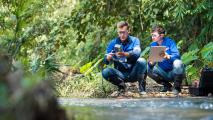Paris has an ambitious plan to make its iconic Seine River swimmable by 2024 — and if it works, it could give other European cities a blueprint for cleaning up their own bacteria-laden waterways.
The challenge: Paris has already announced plans to hold the 2024 Summer Olympics’ opening ceremony at its historic River Seine — but it doesn’t want the river to be merely a scenic backdrop.
The Olympic host hopes to hold some events in the Seine, just like it did for the 1900 Summer Olympics. But swimming in the river has been illegal since 1923, due in part to poor water quality.
“All it takes is a heavy rainfall for sewage overflows to contaminate a section of the river.”
Dan Angelescu
The issue is the Paris sewer system, which can become overwhelmed during heavy rains. Sewage mixes with the rainwater and then flows into the Seine from more than 40 storm drains.
That results in high levels of bacteria that can make people sick, causing diarrhea, nausea, and other health issues.
The idea: To combat this problem, Paris is spending $1.6 billion on a huge subterranean storage tank capable of holding 12 million gallons of water — about as much as you’d need to fill 18 Olympic swimming pools.
The tank will be built under a public garden and be fed by an underground tunnel that collects water from two spillways. Water from the storage tank can then be pumped back into the sewage system as the rain subsides.
“Overflows of wastewater into rivers are happening more often as extreme weather events are becoming more frequent.”
Nicolas Caradot
The city is also testing a floating, autonomous sensor system that measures bacteria levels across the river in real time. The system, called Alert, will help the city track when and where levels are spiking in the Seine.
“All it takes is a heavy rainfall for sewage overflows to contaminate a section of the river,” Dan Angelescu, founder of Fluidion, Alert’s maker, told EURACTIV France.
Alert makes it possible to “quickly access different parts of the river to identify the sources of pollution and study their dispersion,” he added.
The big picture: Paris isn’t the only major European city finding its centuries-old sewage system overwhelmed by rain — and climate change is contributing to the problem.
“Overflows of wastewater into rivers are happening more often as extreme weather events such as heavy rains are becoming more frequent,” Nicolas Caradot, an urban water management specialist, told EuroNews.
So, if Paris’ plan to make the Seine swimmable works out, other cities could end up trying to replicate it with their own rivers — even if there aren’t any Olympians poised to dive into them.
We’d love to hear from you! If you have a comment about this article or if you have a tip for a future Freethink story, please email us at [email protected].






